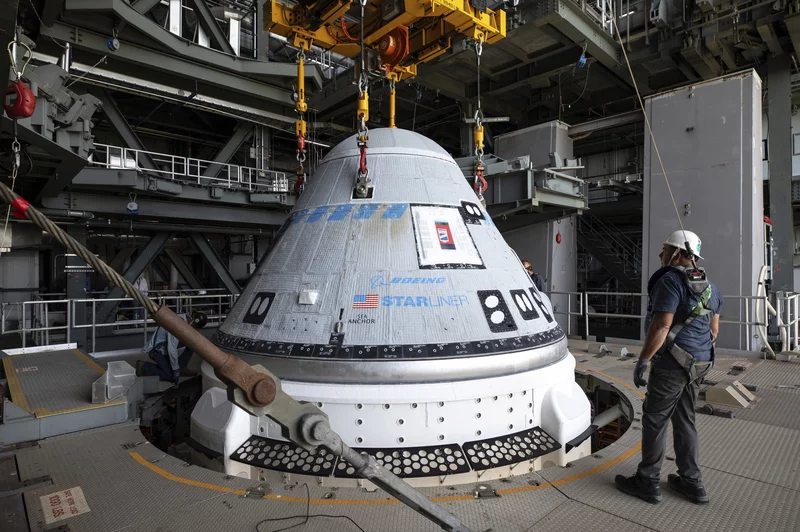“Boeing Starliner, crewed space launch, NASA Commercial Crew Program, space exploration, International Space Station, aerospace technology, space mission delay, spacecraft safety”
“Discover the reasons behind the scrubbing of Boeing’s Starliner first crewed launch to the International Space Station (ISS) and what it means for future missions. Learn about the technical, meteorological, and logistical challenges that led to the decision and how Boeing plans to address these for a successful future launch.”

In a significant development in the realm of space exploration, Boeing’s much-anticipated first crewed mission of the CST-100 Starliner spacecraft has faced a setback as the launch has been officially scrubbed. This article delves into the details of the postponement, the implications for Boeing and its stakeholders, and the future prospects of the Starliner program.
Background of the Starliner Mission
Boeing’s CST-100 Starliner is a cornerstone of NASA’s Commercial Crew Program, which aims to facilitate the transportation of astronauts to and from the International Space Station (ISS) from U.S. soil. Developed to ensure a safe, reliable, and cost-effective solution for crewed space missions, Starliner represents a critical step towards maintaining a U.S. presence in space. Prior to this crewed mission attempt, the Starliner had undergone uncrewed test flights, which were crucial in assessing the spacecraft’s performance and safety measures.
Reasons Behind the Scrubbed Launch
The decision to scrub the launch of Boeing’s Starliner was not taken lightly. It was influenced by a complex mix of technical, meteorological, and logistical factors. Primarily, technical challenges related to the spacecraft’s systems were the main contributors. Issues such as software anomalies, valve malfunctions, or sensor discrepancies can prompt a delay, as these systems play pivotal roles in ensuring the safety of the crew during the mission.
Weather conditions also play a critical role in launch decisions. Adverse weather, such as high winds, lightning, or unstable atmospheric conditions, can jeopardize the safety of the launch, leading to postponements. Additionally, coordination with other space traffic, including satellites and previously scheduled launches, can affect the timing of a launch.
Impact on Boeing and NASA
The scrubbing of the Starliner’s first crewed launch is a setback for Boeing, which has invested significantly in developing a spacecraft capable of ferrying astronauts to the ISS. The delay not only affects Boeing’s timeline for demonstrating its capabilities but also has financial implications, given the significant costs associated with each launch attempt.
For NASA, the delay is equally concerning. As the agency relies on commercial partners like Boeing and SpaceX to transport astronauts, any setback impacts the scheduling and logistics of ISS operations. It underscores the challenges of space travel and the importance of stringent safety standards, which, while causing delays, are essential for the safety of the crew.
Responses and Reactions
In response to the scrubbed launch, both Boeing and NASA officials have reiterated their commitment to safety and the need for caution. In official statements, spokespeople from both entities expressed disappointment but emphasized the importance of resolving all technical issues before proceeding. The astronaut crew assigned to the mission also supported the decision, acknowledging the complexities involved in space missions and the priority of crew safety.
Future Prospects for the Starliner
Looking forward, the Starliner program remains a key element of NASA’s broader strategy for space exploration. The lessons learned from this scrubbed launch will be invaluable in refining the spacecraft’s design and operations. Boeing plans to conduct thorough reviews and tests to address the issues that led to the postponement.
The next steps involve rescheduling the launch, which will depend on resolving the technical issues, ensuring favorable weather conditions, and coordinating with other space activities. Both Boeing and NASA are optimistic about overcoming these challenges and achieving a successful crewed mission in the near future.
Conclusion
The scrubbing of Boeing’s Starliner’s first crewed launch is a reminder of the challenges inherent in space exploration. While it represents a temporary setback, it also highlights the rigorous safety standards and the resilience of the teams involved. As Boeing addresses the issues at hand and prepares for the next attempt, the space community remains hopeful and supportive of the Starliner’s potential to contribute to human spaceflight. The journey to space is fraught with uncertainties, but with each challenge comes learning and improvement, paving the way for future successes in the final frontier.
Read More-
- Curious Asteroid Selam, Spotted by NASA Lucy Spacecraft, Is a Cosmic Toddler
- Groundbreaking NASA Study Reveals New Insights into Global River Systems
- NASA Fermi Reveals the Universe in New E-Book
- NASA Artemis Generation: Cultivating the Moon Trees Across America









